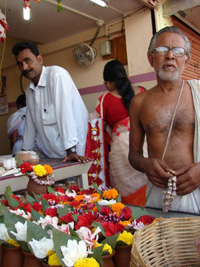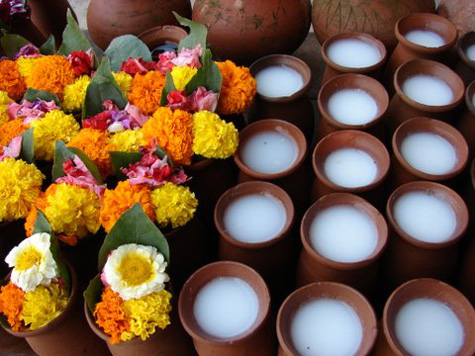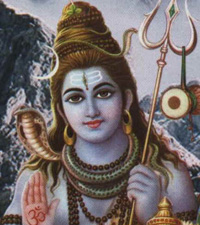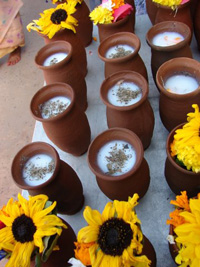Human Flower Project
Great Night of Shiva
Though the great Lord Shiva asked only for fasting and a simple bael leaf offering, today’s pilgrims come with milk, herb, and thousands of flowers.
 A vendor handles a garland of calotropis pods and offers pots of flowers to pilgrims for Monday’s holy rites to Lord Shiva in Tarakeshwar
A vendor handles a garland of calotropis pods and offers pots of flowers to pilgrims for Monday’s holy rites to Lord Shiva in Tarakeshwar
Photo: Sandy Ao
“I am still dazed!” wrote Sandy Ao. And who wouldn’t be?—before countless bouquets like these, alongside pots of milk with cannabis sprinkled on top.
Last Sunday, Sandy visited the Indian town of Tarakeshwar. Its temple, dedicated to the great Hindu deity Shiva, is one of the holiest shrines in the Bengal state. With her husband and three friends, she made the 35-mile trip west from Kolkata in advance of Monday’s holiday Shivarati—“Great Night of Shiva.” Vendors were already offering these herbal milks plus bunches of dahlias, sunflowers, marigolds, and Shiva’s favorite Calotropis, for sale to pilgrims.
“Tarakeshwar is one and a half hour journey by local train from Howrah station,” Sandy writes. “It’s a very peaceful and quiet place. Throughout the year there’ll be devotees coming from far and near to worship Lord Shiva and have a dip in the clear water in the pond. Mondays,” being Shiva’s sacred day, “will have more devotees than other days.”

Shivarati flowers, bael leaves and pots of milk for blessing the Shivalingam
Photo: Sandy Ao
During Shiva’s great summer festival Sravana as at Shivarati, Sandy says, the town is “jam-packed with devotees.”
This early spring holy day (coinciding just about exactly with Chrisianity’s Shrove Tuesday and the beginning of Lent) marks a turning point in Hindu mythology. According to religious legend, demons had poisoned the oceans, threatening all life. (Does this all hit a bit close to home?) The Hindu gods came to Shiva and petitioned him to consume the toxic haalaa-hala and so save the world. The great god “took up his cross” (Christians might say).
 Shiva with cobra around his neck
Shiva with cobra around his neck
Image: sciforums
He swallowed the oceanic poison, so vile it turned his neck blue with heat. That’s why he wears a cooling and protective cobra snake around his neck, better than a lozenge for a sore throat of this magnitude.
The Taraknath Temple was established at Tarakeshwar fairly recently – the 18th century.
“Legend has it that a devotee by name Vishnu Das emigrated with his clan from Oude (Ayodhya) and was viewed with suspicion by the locals. It is believed that he proved his innocence by holding in his hand a red hot iron bar. Later, his brother discovered a site in the nearby jungle, where cattle discharged the contents of their udders (milk) at a particular spot each day. Upon investigation, they discovered a Shivalingam.”
 Sunflowers and pots of milk and cannabis herb, in Tarakeshwar, Feb. 22, 2009
Sunflowers and pots of milk and cannabis herb, in Tarakeshwar, Feb. 22, 2009
Photo: Sandy Ao
Sandy has written for us about the lingam before – a phallic stone that embodies the spirit of Lord Shiva. During both Shivarati and Sravana, in August, pilgrims pour these ritual pots of milk over the temple’s lingam in homage and offering. Shivarati observances also include fasting and offering of the bael leaf, sacred to Shiva.
“This trip to Tarakeshwar was an amazing outing for me, my husband and the three workers from my mother’s shop,” Sandy writes. “In this one and a half hour journey I saw so many scenes different from the city.
“I thought this place would be some very well developed pilgrimage town. It seemed to me to be a simple family puja place, but then looking at the devotees, it is a very religious holy place. Maybe god and goddess don’t reside in a grand temple—they are there for the common human.”
Or how about both, Sandy?
She writes, “I am happy I at last, could visit this holy town and most importantly, to see how they arrange these beautiful flowers for their great god. I have not seen such pretty pots and the beautiful flowers arrangement in any of the city temples.”
Many thanks, friend, for sharing your dazzling visit with us!

